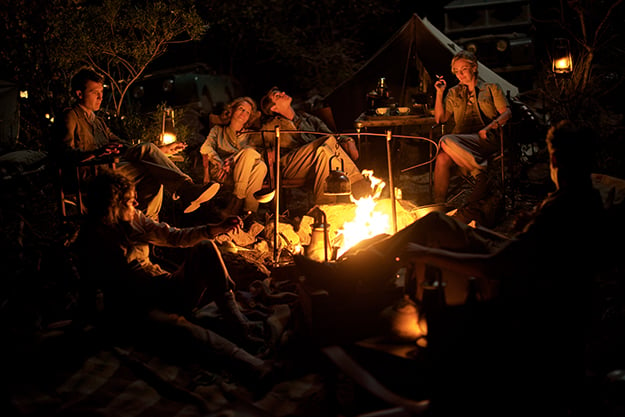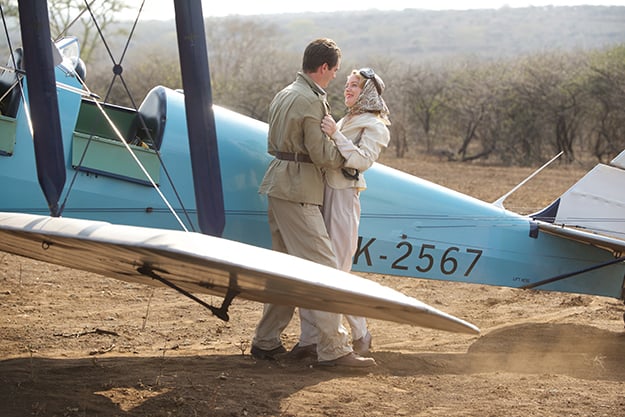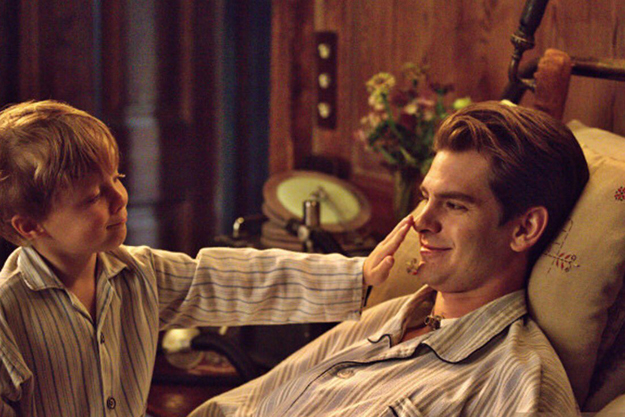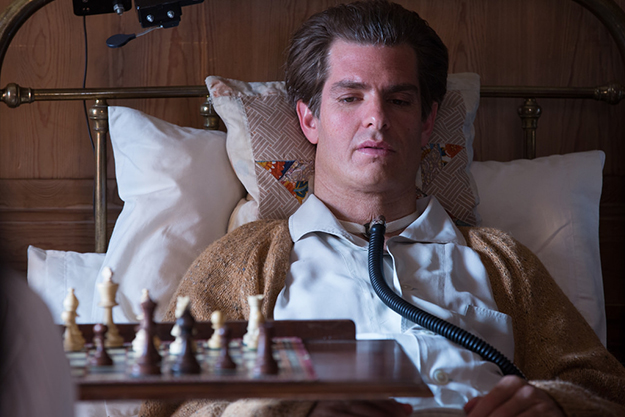Deep Focus: Breathe
Andy Serkis’s Breathe soars out of the inspirational true-story genre into its own airy realm of action-packed high comedy. Andrew Garfield gives his most spirited, expansive performance to date as Robin Cavendish, a swashbuckling British Army vet turned tea broker. In 1957 Robin sweeps the beautiful, headstrong Diana Blacker (Claire Foy) off her feet and whisks her away with him to Africa. They embark on an exciting married life as they ramble across Kenya. Soon they’re celebrating Diana’s first and, it turns out, only pregnancy. Though it seems that nothing can sabotage their bliss, polio soon paralyzes Robin’s body and leaves him dependent on a respirator.
This movie isn’t about a privileged couple surviving leveling setbacks because of the strength of their new realism. It’s about recharging their shared romantic soul and turning Robin’s existential challenge into an exuberant quest. Robin doesn’t experience a breakthrough cure. He accepts that he’s a “responaut”: to quote Oxford Living Dictionaries, “a person permanently dependent upon a ventilator (artificial respirator) to maintain breathing.” What Robin, Diana, and their simpatico kith and kin don’t accept is that being a responaut means staying strapped to a stationary bed. By the end of this movie, “responaut” becomes a term of adventure every bit as thrilling as “astronaut.”
It takes a while for Robin to blast off. Flown back to Britain and installed in a hospital for long-term care, Robin wants to cut Diana loose: she’s 25, with most of her adult life ahead of her and all of her new child’s. Robin, 28, comes close to drifting off into oblivion. But Diana refuses to give up on him. Once she engineers his exit from the hospital (his first wish) and sets him up in a capacious, dilapidated country house, he regains his delight in meaningful risk. He develops the mobile “Cavendish Chair,” equipped with a lightweight, battery-operated respirator, in collaboration with his friend, Professor Teddy Hall—Downton Abbey’s Hugh Bonneville, exuding maverick panache. (This jack of all sciences earlier had exposed the faked prehistoric skeleton known as the Piltdown Man and would later devise a valid carbon-dating scheme for the Shroud of Turin.) Exhilarated by his newfound freedom, Robin determines to spread his good news and liberate his fellow responauts from hospital wards and disability institutes that are more like prisons.
Robin’s grounded yet miraculous transformation plays out in a real-life world of fable. Serkis, screenwriter William Nicholson (Shadowlands), and producer Jonathan Cavendish, Robin’s son, know exactly what they’re doing in the film’s giddy, swoony first act. They establish the England of cricket fields and coming-out parties and the Kenya of picturesque camp sites, tea warehouses, and tennis courts as garden spots for true love and playfulness—for people who enjoy their good fortune without guilt or stupidity.
In Diana’s upper-crust environment she complains of not having enough money, then pays 7,000 pounds, cash, for their rundown yet august family manse. (She has persuaded the seller to reduce the price by thousands.) Her twin brothers, David and Bloggs Blacker (puckishly played by Tom Hollander), show up to assist at any time, just as Teddy appears whenever and wherever he’s needed, in England or on the Continent, and fashions the chair without any outside funding. This movie takes a generous view of people who live “in a bubble,” whether in colonial Kenya or in Hertfordshire. It acknowledges their insularity but also salutes their pride, resourcefulness, loyalty, humor, and best of all, their stylish sort of dignity. This movie’s signature song is Cole Porter’s “True Love” from High Society, the 1956 musical remake of The Philadelphia Story. Breathe in effect puts us in the position of the James Stewart/Frank Sinatra character, who can’t resist Katharine Hepburn/Grace Kelly—except here we fall in love with both Robin and Diana. (In a humorous coup, the soundtrack also salvages Lee Marvin’s rugged rendition of “Wandering Star” from the 1969 film version of Paint Your Wagon.)
With the help of that superb cinematographer Robert Richardson (The Aviator, Hugo), Serkis imbues the look of his movie with infectious buoyancy. Even when the landscapes scream Out of Africa, there’s fervor and lift to them. Serkis and Richardson conjure a seductively sunny view of England as Shakespeare’s “other Eden, this demi-paradise, this fortress built by Nature for herself.” Outside of the hospital, the lush, detailed images vibrate with possibility. Costume designer Charlotte Walter adds to the ambience with a cascade of boldly colored cravats and vests and sports coats; she makes the film seem like a costume party long before Serkis stages an actual costume party. (Diana’s favorite hat resembles the air-bag part of a ventilator, in its down position.) Along with an ingenious production designer, James Merifield, they help Serkis create moods that combine adult passion with childlike resilience and bounce. In Robert Louis Stevenson’s “A Child’s Garden of Verses,” the boy narrator of “Pirate Story” proclaims:
Winds are in the air, they are blowing in the spring
And waves are on the meadow like the waves there are at sea.
Where shall we adventure, today that we’re afloat,
Wary of the weather and steering by a star?
Shall it be to Africa, a-steering of the boat,
To Providence, or Babylon or off to Malabar?
In his Cavendish Chair, Robin experiences how that child feels in his “basket on the lea.” If he can’t take his wife and son to Africa, they’ll go on a pleasure trip to Spain.
At the start of her Robin-reclamation plan, Diana states one goal: getting Robin’s son to know his father. But Foy’s marvelous deep eyes, her skill at conveying passion beneath composure (showcased in The Crown), express another motive: Diana loves looking at her husband, caressing him, and experiencing the pleasure of his company. And what good company he is! Given the chance, Garfield has always been a first-rate romantic lead. In their two Spider-Man movies, he and Emma Stone cooked up dynamite comic-romantic chemistry. They were like Hepburn and Tracy crossed with Martin and Lewis. Foy and Garfield act in a continuum. He provides the spark, and her yearning fuels the fire.
On last week’s CBS Sunday Morning the real-life Diana Cavendish, in her proper British cadences, said, “Andrew managed to get the twinkle in Robin’s eye extremely well.” Indeed. It charges his entire presence and energizes almost every scene. Perhaps the technical demands of the role—mastering the smallest facial muscles and a tiny twitch of the head, breathing and speaking in rhythms set by the respirator—unleashed his inner scamp. Garfield often turns Robin’s measured responses to catastrophe into amiable laugh-lines—gentle parodies of British understatement. Robin must rely on his facial expressions to punch home messages that he can speak solely in carefully patterned sentences. His smile reveals his core, but it’s also a triumph of the will. Garfield embodies that rarity in movies: a complexly happy man.
Serkis surrounds Garfield with something just as unusual: a happy movie. It’s no surprise that Serkis, a protean performer himself, would exact, to perfection, varying blends of empathy, intelligence, and irony from actors like Stephen Mangan, who plays Robin’s ally, Clement Aitken, director of the Disability Research Foundation, and Diana Rigg, who plays Lady Neville, a haughty donor to the cause. And Serkis’s expertise in motion-capture, including his masterpiece performance as Caesar in the Planet of the Apes trilogy, was probably a conscious and instinctive aid to Garfield at achieving maximum eloquence with limited means. But Serkis promises to become The Compleat Filmmaker. He’s even got a visual sense of humor. It’s inexplicably funny and tremendously moving to see Robin wake up to find his cherubic son and snappy terrier staring at him.
Serkis doesn’t always sustain the film’s euphoria, particularly in the scrappy Spanish sequence. And when Robin develops “respirator lung,” the director’s style doesn’t expand enough, or further deepen. But even the movie’s minor failures reveal the love at its core—the producer’s for his parents and the director’s for their story. The ending is genuinely bittersweet. Up to then, Serkis and company make us feel, not trapped in a bubble, but gloriously ascending in a multihued and majestic hot-air balloon.
Michael Sragow is a contributing editor to Film Comment and writes its Deep Focus column. He is a member of the National Society of Film Critics and the Los Angeles Film Critics Association. He also curates “The Moviegoer” at the Library of America website.











